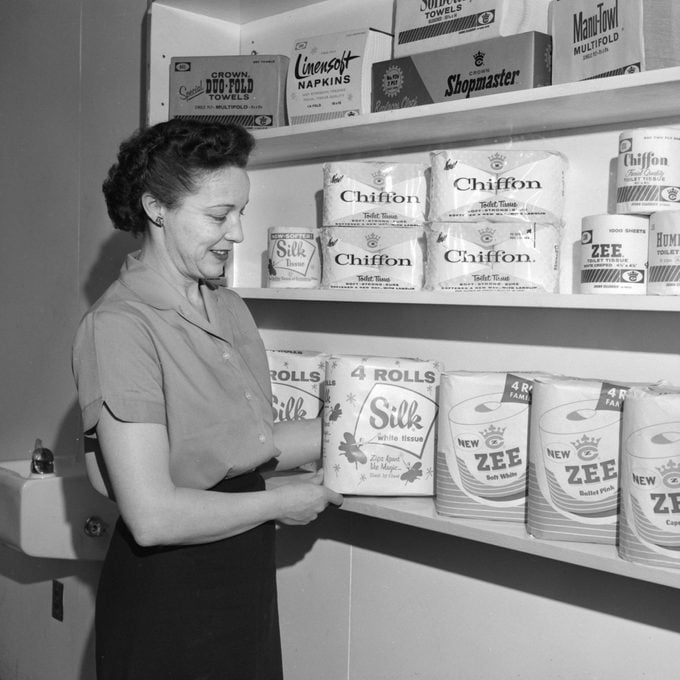When Was Toilet Paper Invented?
Updated: Apr. 15, 2024

Toilet paper! Everyone uses it, but how many of us really know its history?
In the U.S., toilet paper is found in homes, restaurants, hotels, workplaces, and most every public building. And like many omnipresent items, it seems like it’s always been around.
And that got us wondering: Just when did toilet paper enter everyday life?
On This Page
A Natural Impulse for Cleanliness
The need for post-toilet hygiene predates any kind of recorded history.
In his book Bum Fodder: An Absorbing History of Toilet Paper, Richard Smyth says this need for cleanliness is inherent to our existence. According to Smyth, prominent primatologists like Jane Goodall observed “mother chimps diligently wiping their children’s behinds with leaves” and adult chimpanzees cleaning themselves in the same fashion.
Smyth makes the case this need is even more pronounced in humans because we walk on two legs, requiring larger and more muscular rear ends than other primates. It’s clear we have an innate need for back-end cleanliness. But what did our ancestors do before paper existed?
Before Toilet Paper: Ancient Sanitary Solutions
For most of human history, humans used whatever was close at hand.
Ancient Greeks used a variety of implements for toilet hygiene. Archeologists have found “pessoi” — flat terracotta discs with rounded edges resembling river stones in Greek latrines. And the ancient playwright Aristophanes made scatological jokes based on the Greek proverb, “Three stones are enough to wipe.”
Romans used a “tersorium,” a sponge attached to a stick. It was stored in a saltwater or vinegar mixture between uses. Sailors on ocean-going vessels often kept a frayed rope soaked in salt water for their needs.
As late as the 19th century, it was common to recycle items, including corncobs. A poem by James Whitcomb Riley immortalized just how uncomfortable this could be in winter.
Early History of Toilet Paper
The earliest references to paper products for hygiene come from China. In Science and Civilisation in China, Joseph Needham and Tsien Tsuen-Hsuin reference a Sixth Century document that “refers to the prohibition of papers with characters being used for such purposes.”
By 1393, according to Needham and Tsien, records indicate the Bureau of Imperial Supplies produced 720,000 sheets of toilet paper for the general use of court. These were large (2- by 3-ft.) and simply made. By contrast, another 15,000 sheets made for the exclusive use of the imperial family were smaller (3-in. by 3-in.), light yellow and described as “thick but soft, and perfumed.”
Improvised Toilet Paper: Take a Page From Your (Least) Favorite Book
As printed materials grew in popularity and paper was no longer a precious commodity, it began to be used in the bathroom.
Newspapers and catalogs like the one from Sears, Roebuck & Co. were popular choices for ad-hoc toilet paper. The Farmer’s Almanac embraced this use, adding a hole in the corner to make it easier to hang in outhouses.
But in 1857, that all changed with the introduction of toilet paper.
Toilet Paper in the Modern Age

Joseph Gayetty is widely considered the father of modern toilet paper. Thanks to the Library of Congress, we can still see the advertising copy declaring his invention the “Greatest Necessity of the Age!”
Gayetty’s pitch noted recycled catalogs and newspapers were hazardous to your health. “Printed paper,” the ad read, “is rank poison to tender portions of the body. Individuals would not put printer’s paper in their mouths.” Yet, it read, people had no hesitation “applying that ink to the tenderest part of the body corporate.”
To ensure consumers could avoid knockoff toilet paper, they were urged to look for the watermark — Gayetty’s name appeared on every sheet. He seemed determined to keep his name in front of consumers, even if his product was behind them.
There’s no doubt Gayetty’s aloe-infused toilet paper was much more comfortable than other options of the day. But it was expensive. Adjusted for inflation, it cost more than $16 for the equivalent of a roll-and-a-half.
Of course, Gayetty’s product didn’t come on a roll at all, but as a stack of individual sheets similar to a box of tissues. The roll was the next innovation in toilet paper.
Toilet Paper on a Roll
Seth Wheeler, one of several inventors riffing on Gayetty’s toilet paper concept, is credited with inventing the modern toilet paper roll. Other patents issued around the same time included toilet paper bundles and coin-operated toilet paper dispensers, but Wheeler’s design endured the test of time.
Wheeler earned three key patents that established toilet paper as we now know it:
- Patent US361603A (1887): Wheeler’s original toilet paper roll patent.
- Patent US422866A (1890): Wheeler’s initial perforated toilet paper roll.
- Patent US465588A (1891): This improved toilet paper roll is the basic design still in use today.
Toilet Paper Today
Today, toilet paper is practically everywhere. That’s why it was shocking when toilet paper became hard to find during the COVID-19 pandemic. Here’s many people don’t know: A nearly identical toilet paper panic happened 45 years earlier.
In 1973, America was in the midst of the energy crisis. Gas station lines stretched for blocks, and tensions were high. So when The Tonight Show host Johnny Carson made a casual joke about toilet paper being the next shortage, consumers rushed to the stores.
It’s notable that both toilet paper panics occurred during wider, more serious crises. According to Boston University economics professor Jay Zagorsky, these responses reflected a desire to find control in uncertain times.
“You might run out of something else,” Zagorsky told CBS Sunday Morning, “but at least you have one of the staples that make most people feel better.”
So the next time we face an existential crisis, you may want to have some spare rolls hidden away. Or at the very least, make sure you’ve got three stones.